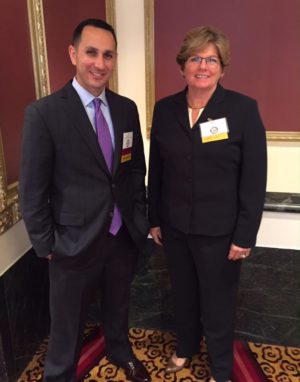NYSBCA Convention – Key Takeaways

Bill Zeronda, Jeff Klahr, Mary MacKrell and Jennifer Getter of LCS&Z, LLP attended the 61st Annual New York State School Bus Contractors Association‘s Convention on October 16-17th in New York, NY. Jeff and Mary presented on the 2015 Federal and New York State tax law changes, with a focus on how the final tangible property regulations impact the transportation industry.
Listed below are a few key takeaways from the presentation:
New York State Tax Law Changes
- Tax years beginning on or after January 1, 2016, the top tax rate (based on Entire Net Income) for C corporations will drop from 7.1% to 6.5%.
- The tax rate for the capital base tax will phase out from the current 0.15% to 0% by 2021.
Metropolitan Transportation Tax
- Applies to taxpayers that do business, employ capital, own or lease property, or maintain an office in the following counties: New York, Bronx, Kings, Queens, Richmond, Dutchess, Nassau, Orange, Putnam, Rockland, Suffolk, Westchester.
- In 2015, the rate increased from 17% to 25.6%, and was made permanent.
Tangible Property Regulations
These new regulations present risks and opportunities that affect taxpayers in every industry, including transportation.
Materials and Supplies
Changes to materials and supplies only apply on a go-forward basis. You simply needed to adopt the regulations as of January 1, 2014. You do not have to go back to prior years and correct any prior treatment using a Form 3115, Change in Accounting Method.
Materials and supplies are defined as tangible property, excluding inventory, that are used and consumed in operations and are:
- A component acquired to maintain, repair or improve a unit of tangible property
- Fuel, water, lubricants and similar items that are reasonably expected to be used in 12 months or less
- Unit of property whose useful life is 12 months or less
- Unit of property with a cost of less than $200
The regulations further break down materials and supplies into two categories: Incidental and Non-incidental.
Incidental: can be deducted when they are purchased, assuming there is no record of consumption or physical inventory taken.
Non-incidental: should be capitalized and deducted when they are used.
The IRS has offered some relief in the form of adopting elections:
De minimis Safe Harbor Election
The De minimis safe harbor election is an annual election made by attaching a statement to your income tax return. Taxpayers who have an applicable financial statement (AFS) can deduct up to $5,000 of the cost of an item. An AFS is one that is audited or filed with the SEC. For those who do not have an AFS, the $5,000 limit is reduced to $500.
Routine Maintenance Safe Harbor
Allows taxpayers to expense certain maintenance costs that are routine and reoccur during the use of a unit of property.
This safe harbor rule also applies to buildings and their structural components. In the case of a building and its components, expenditures can be treated as a repair if you reasonably expect to perform the repair more than once over a 10 year period of time.
Safe Harbor Election for Small Taxpayers
An annual election not to capitalize improvements to eligible buildings:
- Average annual gross receipts of less than $10 million for the prior three taxable years
- Own or lease a building with an unadjusted basis of $1 million or less
- Total amount for repairs, maintenance, improvements, or similar costs does not exceed the lesser of $10,000 or 2% of the unadjusted basis of the eligible building
- Election made by attaching a statement to your income tax return
Small business taxpayer
A small business taxpayer is one that has either 1)gross assets or 2) average gross revenue over the last three years of less than $10 million. Meaning the taxpayer can have assets or revenues greater than $10 million. However, if the taxpayer has multiple businesses, any business that is below either threshold on a standalone basis qualifies for the relief. Any business that qualifies as a small business taxpayer is not required to file a Form 3115 merely to state that it is complying with the new regulations.
If you are unable to utilize the safe harbors available under the regulations, you will have to run the repair cost through a multi-step test to determine whether the expenditure represents a:
- Betterment: returns the unit of property to working order from a state of nonfunctional disrepair, therefore extending its life
- Restore: replaces a major component or substantial structural part of the unit of property
- Adapt: improvements adapt the unit to a new or different use
Dispositions
For calendar year taxpayers, the regulations allow taxpayers the opportunity to partially dispose of duplicate portions of property, including buildings and their structural components. For example, in the past if you replaced a roof on a building, the cost of the new roof was capitalized, but you were not allowed to dispose of the prior roof. Under these regulations, you may dispose of the old roof.
If you are a June year end, it is not too late, consider going back and scrubbing the pre-2014 depreciable asset schedule. If you don’t go back and scrub, you also lose the right to make a late partial disposition election in 2014, which means it’s gone forever. Additionally, if you don’t scrub your depreciation, you also don’t get audit protection for 2012 and 2013.
